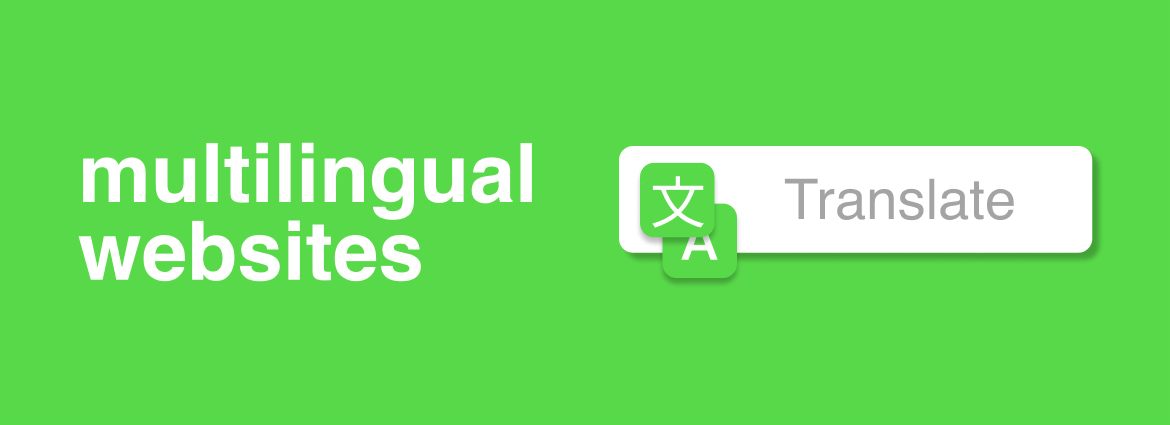Michael Addison Director of Technology
Why build a multilingual website?

If members of your target audience don’t all speak the same language, it just makes sense to have a multilingual website. If you don’t have such a site, have you ever taken the time to consider how effective it could be for your business and what it would take to maximize its effectiveness?
It might be tempting to simply activate a plugin that automatically translates all your content, but if you’ve ever actually used a site like this, you will have realized that it makes you feel like you were an after-thought and fails to instil the confidence that you could have an effortless conversion with someone at the company. Unless your content is written and localized properly for a specific target group, potential customers will probably end up with your competitors.
We’ve put together some key points for you to consider when deciding how to create or improve your multilingual website.
Localizing your website
If you choose to build your e-commerce site on Magento, it can be used with the Magestore extension to become an online point of sale (POS). This launches a POS screen on your computer or iPad and allows customers to make payments in-store. It also lets you set the language. Since the Magestore extension is linked to the online store, the greatest advantage is that everything — including inventory records and customer information — can be managed consistently. For example, if a customer has already registered as a member online, you can link to the customer’s data at the POS when they make a make an in-store purchase and check their reward points and purchase history. Also, when an item is purchased at the store, the available stock on the online store is automatically updated.
Creating a multilingual website is more than just translating the words. Well-localized sites ensure that every detail is suited to a particular language, country, and culture, including:
- images
- currency
- weights and measurements
- dates and times
- functionality
- design
- text that reads like it was written by a native speaker
If any one of these elements hasn’t been considered carefully enough, it could result in an undesirable perception of your company and product. The goal is to make each member of your audience feel as though your business is for them. Even if your native language isn’t theirs.
Benefits of multilingual websites
1. Reach a wider audience
The obvious advantage to using another language online is that you open your business up to a massive new audience. These are people who may have never heard about your business in their mother tongue before. Surveys show that most non-English-speaking online shoppers prefer to buy products in their native language. Just over half rarely ever visit English websites. Considering the vast market in the Asia–Pacific region, the potential for new business is great. With the right site, you could start communicating with a much largest audience than you do now.
2. Achieve better client satisfaction
Well-localized websites lead to increased client satisfaction. Assuming that your site’s user experience is optimal, your shopping cart is working, and your message is appealing, your customers should feel an increased sense that you have put the time and effort in for them. This leads to more conversions, better reviews, and repeat business.
3. Get a search engine boost
By making your website appropriate for different regions, search engines take notice as users from those regions use your website more. If you have researched which keywords each region prefers for your specific offering — and made sure you are meeting their search result expectations — your website will certainly get a boost from Google.
4. Rank higher due to less competition
While this depends a bit on the business you’re in and which market you are trying to break into, one thing is for certain: It doesn’t pay to wait. More and more companies are realizing that localization is critical for their online business to succeed. So, don’t get left behind.
5. No penalties for duplicate content on translated websites
There’s no need to worry that you may be penalized for having duplicate content on your site. Setting up hreflang tags helps search engines understand which pages are translations and allow them to better present the correct page to users. The process is fairly simple, and it’s even automated on many websites.
6. Increase your sales and conversions
After putting in the effort to localize your website, you would expect some sort of return. It’s worth thinking about your return on investment for localizing. Choose regions and languages that have the largest market for your product or those where there is less competition. You could probably start by looking at your current site analytics to see if there is any interest from foreign users already.
The very fact that you are reading this article shows you realize that creating a multilingual website is a smart choice, especially if your business is operating in an international market already or you want to break into a new one.
Feel free to contact us for more information — we can help you with every step.


